Nature is decorated with a range of colors. In some spiders, color means danger, such as bright reds and yellows. Blue is not a common color seen on spiders with only a handful being blue or having some shades of blue on the body. The blue is sometimes distinctive.
If you have seen a blue spider or you are interested in which spiders are or have blue on them, continue reading below.
Table of Contents
Are There Blue Spiders?
It’s not common to find a spider that is blue or has blue on it, except for the popular blue tarantulas in the pet trade, such as the Cobalt Blue Tarantula (Cyriopagopus lividus). The 25 spiders listed below have blue on the whole body or have blue markings.
25 Types of Blue Spiders
The 25 types of blue spiders from around the world includes:
1. Cobalt Blue Tarantula
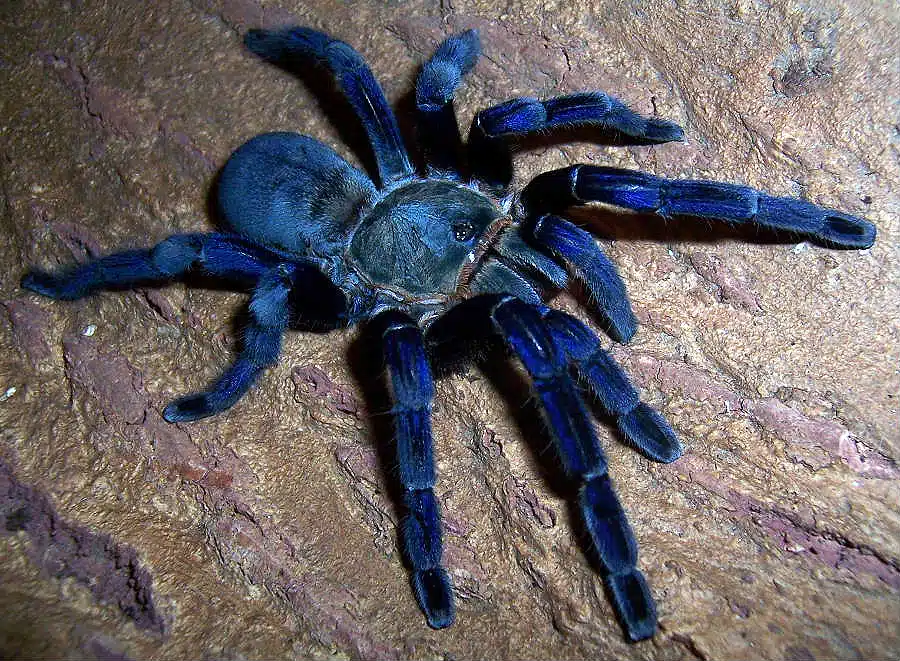
Scientific name: Cyriopagopus lividus.
Common name: cobalt blue tarantula.
Cobalt blue tarantulas can grow to a leg span of 13cm and are considered medium-sized tarantulas. They are known for their blue legs.
The males and females look the same until their final molt when males become light tan to bronze in color. Females grow larger than males. They are not commonly sighted as they spend their time in underground burrows.
These tarantulas live in the tropical rainforest of Southeast Asia. They dig deep underground burrows, which they only leave in search of food.
These are common spiders in the pet trade. They are fast and defensive with venom that can cause inflammation and muscle cramping.
2. Brazilian Blue
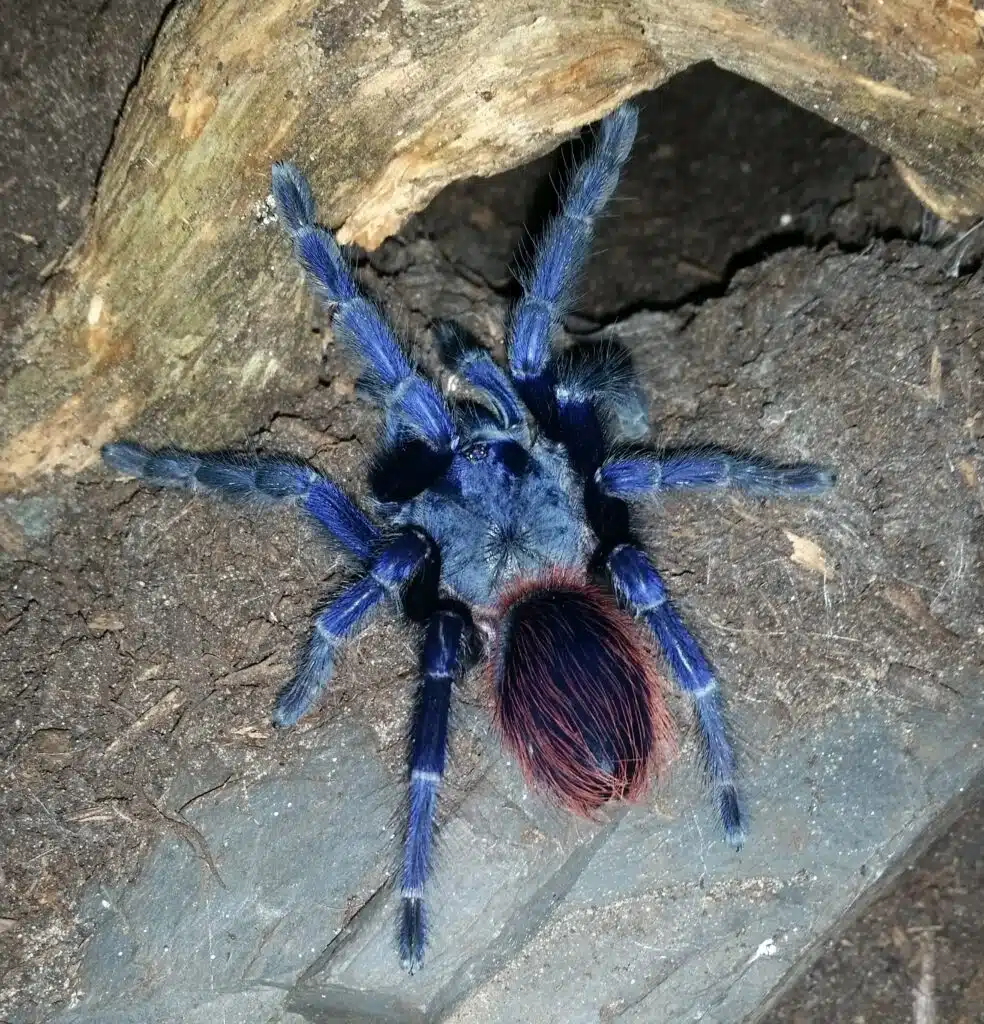
Scientific name: Pterinopelma sazimai.
Common name: Brazilian blue, Sazima’s tarantula.
The Brazilian Blue is a beautiful South American tarantula, which can be found in Bahia, Gerais, Chapada, Minas, and Diamantina in Brazil. This is a beautiful blue tarantula, which is growing in popularity in the pet trade.
When you first see these tarantulas, they look black with red hairs on the abdomen. When their body is in the light, they are a stunning blue. These are burrowing spiders, which hide in deep burrows, though some have arboreal traits.
They are nervous and skittish spiders and will flick urticating hairs at any threat. These hairs can cause skin irritation in humans. They grow to 15cm and are New World tarantulas with a medium to fast growth rate.
3. Greenbottle Blue Tarantula
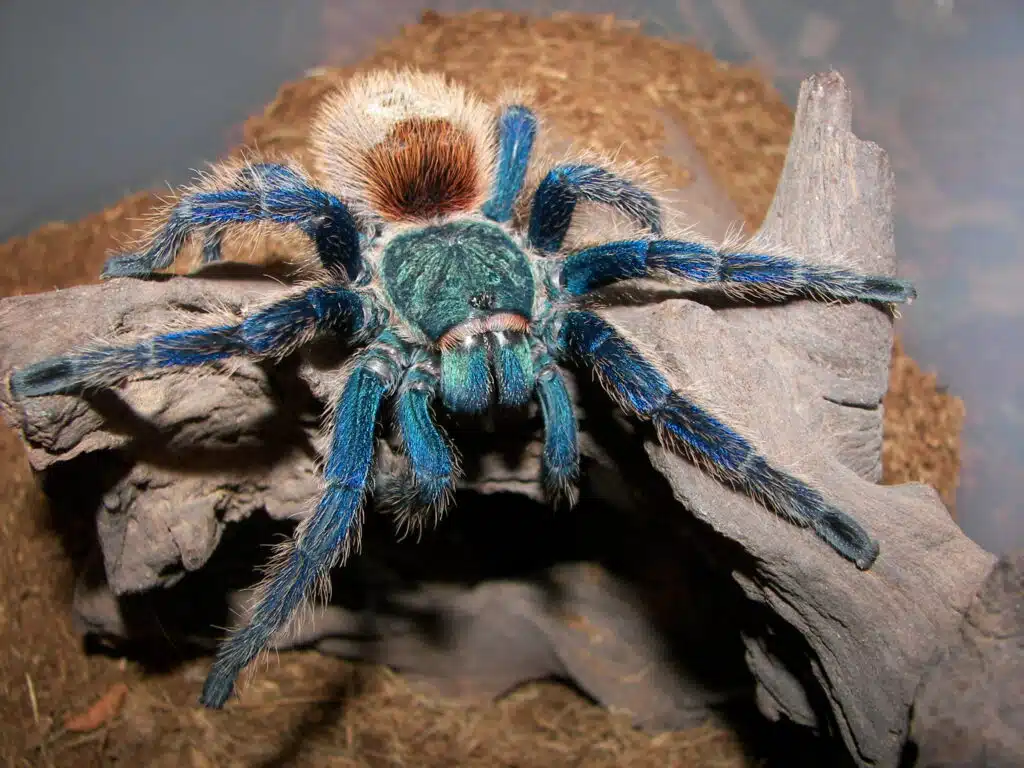
Scientific name: Chromatopelma cyaneopubescens.
Common name: greenbottle blue tarantula.
The greenbottle blue tarantula is a South American tarantula. These spiders have a green/blue carapace and metallic blue legs. They are fast-growing and very attractive in the pet trade.
These tarantulas live in webbed burrows, usually located under tree roots and bushes in the desert areas in northern Venezuela. They create webs across their burrow entrance, which protects them from the harsh climate.
4. Metallic Blue Jumper
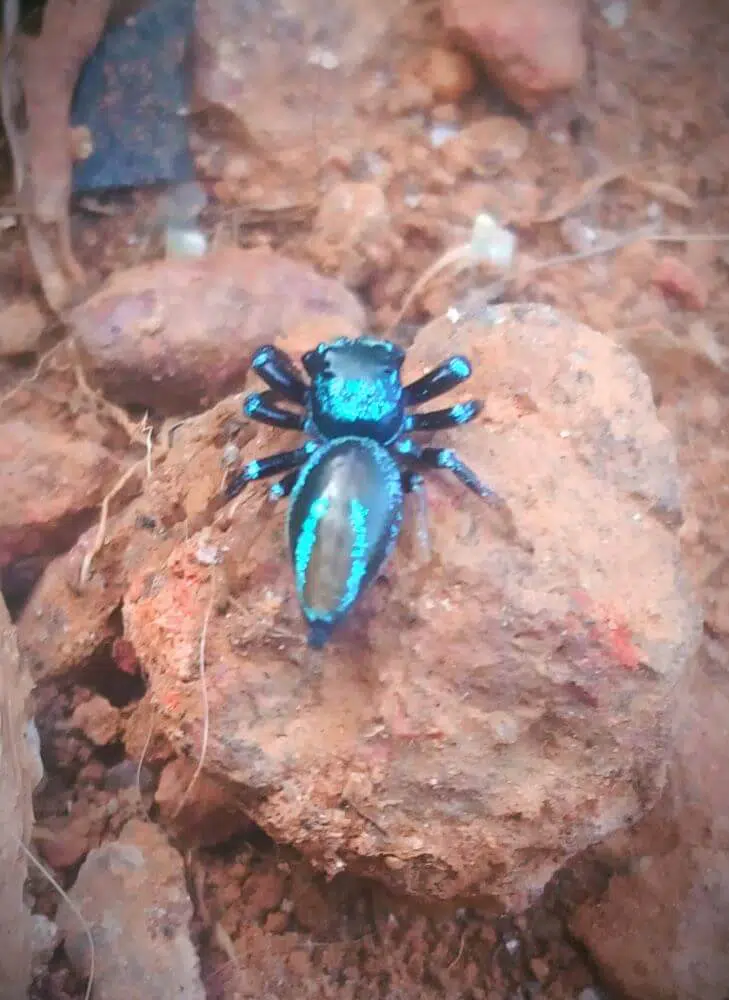
Scientific name: Thiania bhamoensis.
Common name: Metallic Blue Jumper.
The Thiania bhamoensis is a jumping spider that is an iridescent blue/green color. The females tend to be more of green color, while males tend to be more blue. Females have a black face, while males have a white face.
These spiders create silken retreats, where they rest, lay their eggs, and molt. This is not a normal behavior for jumping spiders. The thiania bhamoensis is common in Burma and Sumatra.
5. Red-headed Mouse Spider
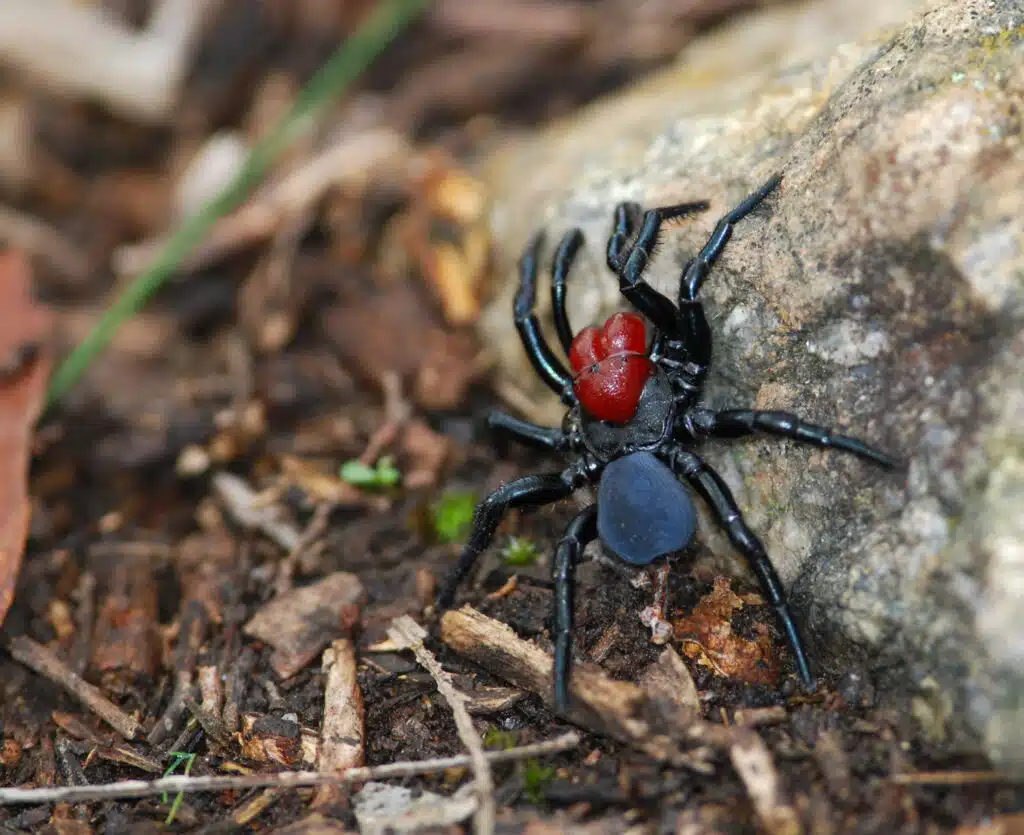
Scientific name: Missulena occatoria.
Common name: Red-headed Mouse Spider.
The red-headed mouse spider is found in southern Australia. They are common in open forests and desert shrublands. Females can grow to 24mm and males to 12mm in body length.
These spiders dig deep burrows with two trap doors. The females are black with a red tinge to them, while males have bright red heads and jaws with a blue to black abdomen.
These are toxic spiders with most bites usually causing minor effects. Bites to children and the elderly may have more serious side effects and can be treated with a spider anti-venom.
If bitten, seek medical attention as soon as possible. If you can take the spider with as identification. Alternatively, try and remember what the spider looked like to assist with identification.
6. Chrysilla Volupe
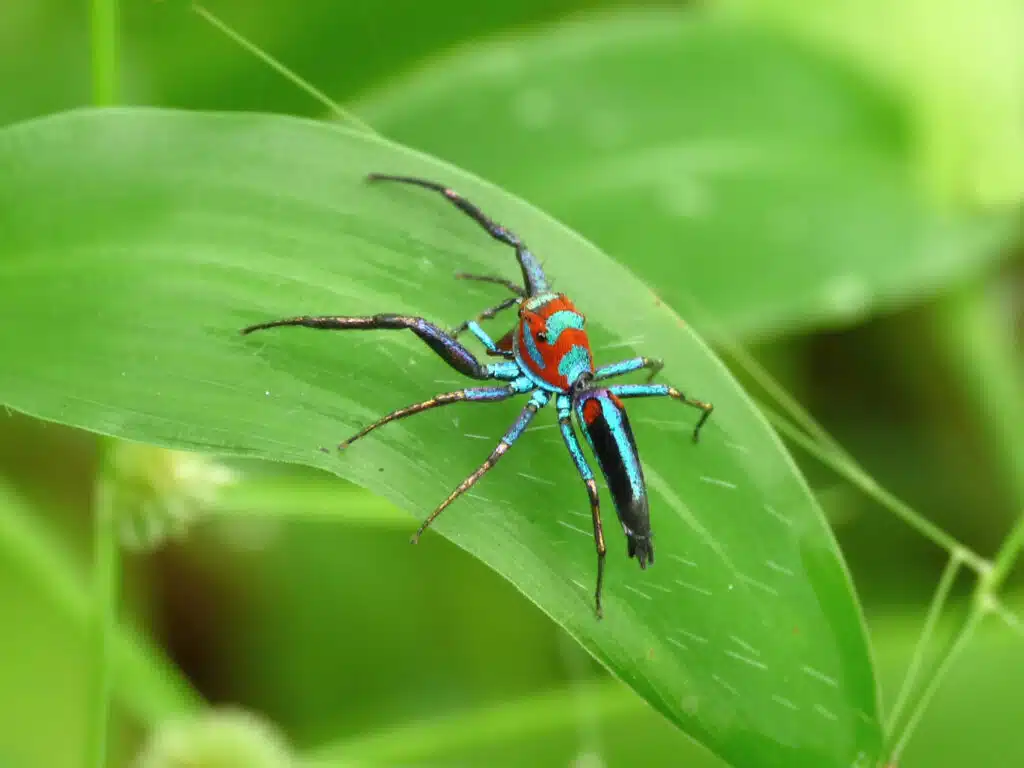
This is a jumping spider found in Sri Lanka, Nepal, India, and Bhutan. The males have a red/orange carapace with two blue stripes. Their legs are golden with purple shades.
The female has a gray carapace with yellow legs.
7. Martinique Pinktoe
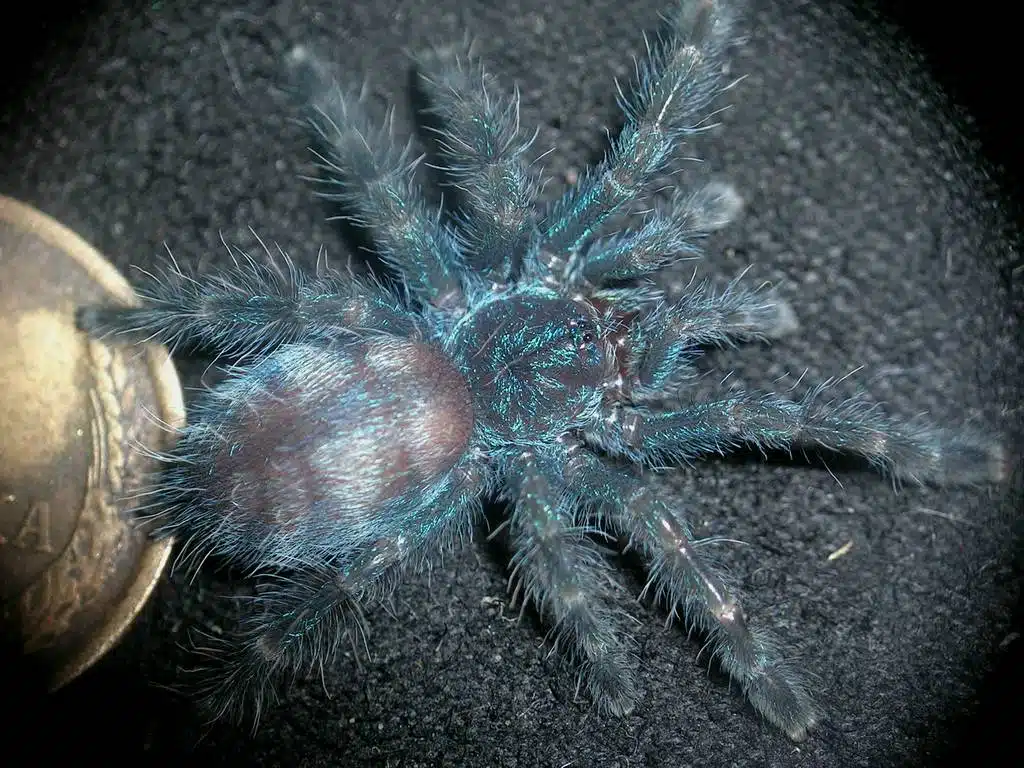
Scientific name: Caribena versicolor.
Common name: Martinique red tree spider, Martinique pinktoe.
The Antilles pinktoe tarantula is also known as the Martinique red tree spider. It is a docile spider with a beautiful and unique color. They are native to Martinique in the Caribbean.
These tree-dwelling tarantulas spin funnel webs, where they hide the majority of the time. When spiderlings are born, they are a bright blue color with a unique tree trunk pattern in black on their abdomens.
With each molt, they lose the blue and the carapace turns to a green color. Their abdomen turns red and their legs turn green with pink tarsi and purple hairs. Males tend to be a brighter color than females.
This is a docile and very popular tarantula in the pet trade, though they don’t enjoy being handled. If they do bite, their bite is no worse than a bee sting. They do have urticating hairs, which can cause redness and irritation on human skin.
8. Peacock Tarantula
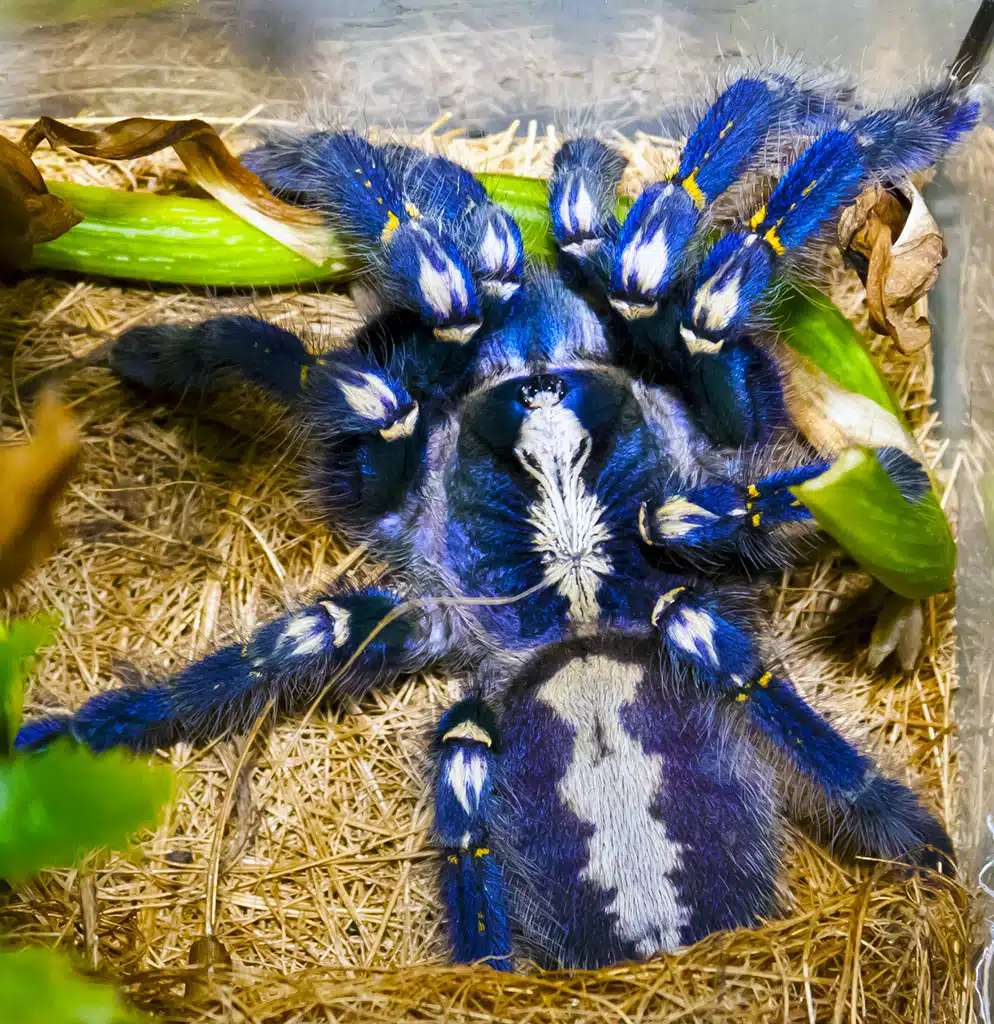
Scientific name: Poecilotheria metallica.
Common name: Peacock tarantula.
The peacock tarantula is an Old World tarantula species and the only blue tarantula in the Poecilotheria genus. It has an intricate fractal pattern on its abdomen.
They live I the deciduous forest of Andhra, Pradesh in southern India and is classified as Critically Endangered by the IUCN. These tarantulas are covered in blue hair. Their coloration turns blue with each molt.
Blue is not as significant in mature males, who are also more slender than females with longer legs. They can reach a leg span of 20cm.
Their natural habitats is an area of less than one hundred square kilometers, in a reserve forest. They live in the holes of tall trees, where they make funnel webs. They are known to live in a community if there are only a limited number of holes in the tree.
They are a very skittish species and will try and flee. They are known to bite if provoked.
9. Sea-green Northern Jumper
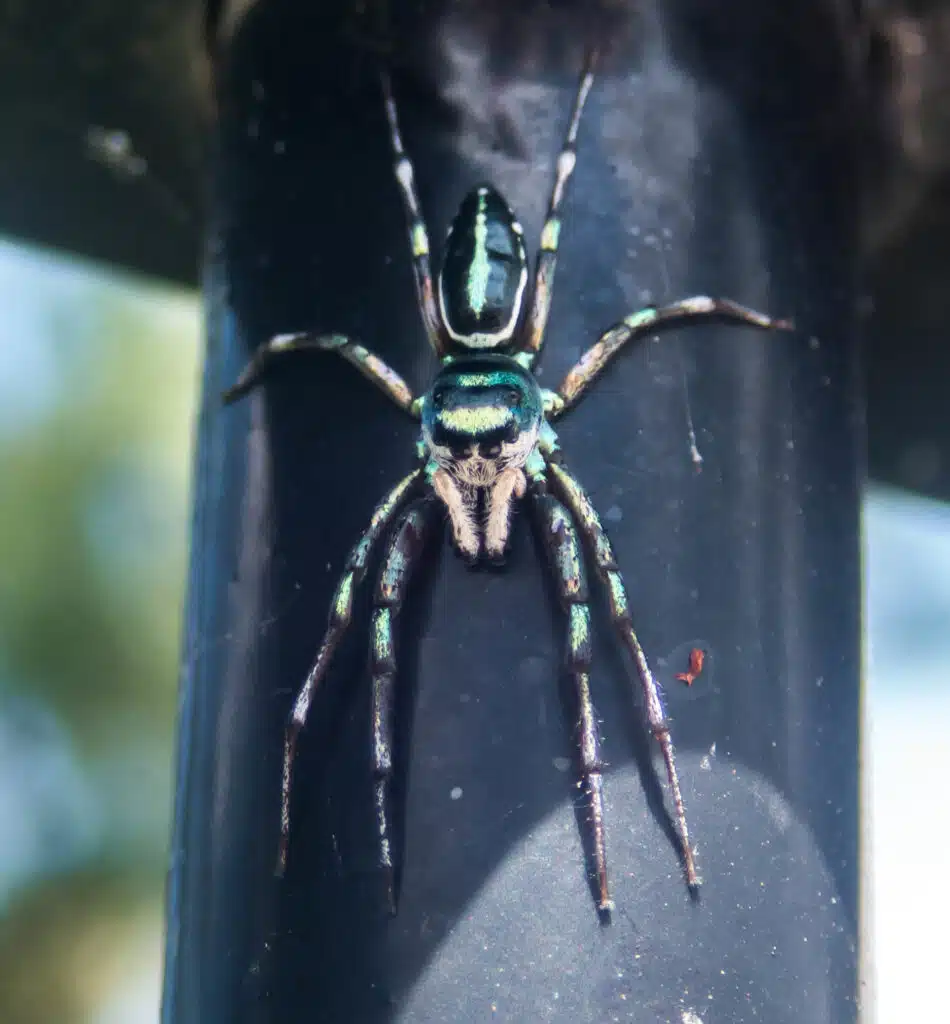
Scientific name: Cosmophasis Thalassina.
Common name: Sea-green Northern Jumper.
This jumping spider can be found from Australia to Malaysia. They have a green/bronze-colored carapace with copper hairs. Some have black banding.
They have a dark opisthosoma and a white collar that runs halfway down each side. They have a grating with a broadband multilayer reflector which is blue. This can be seen when you shine a light on the spider.
10. Golden Blue-legged Baboon Spider
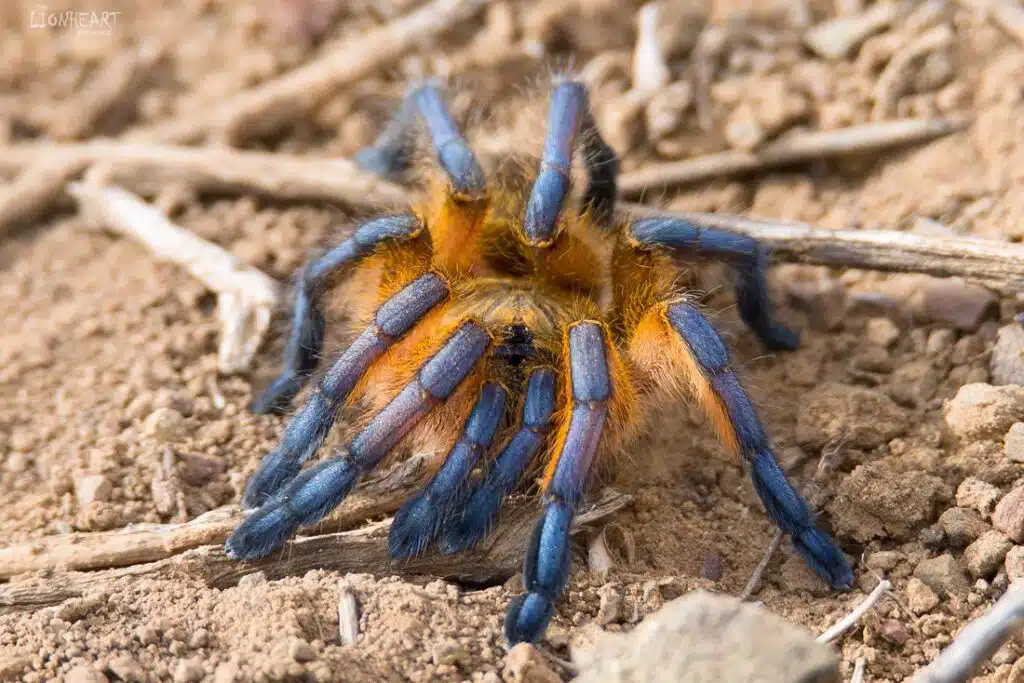
Scientific name: Harpactira pulchripes.
Common name: Golden blue-legged baboon spider.
The golden blue-legged baboon spider has a bright yellow body with metallic blue legs. It is native to South Africa and popular in the pet trade in America and Europe.
These spiders are medium in size, growing to 13cm when adults. They have a docile temperament, though they are still a spider, so take care. These are burrowing tarantulas, that create burrows underground and line them with a funnel web.
The coloration can range from light brown to black and orange to gold. These colors are enhanced by the ash blue legs.
11. Black Lace-weaver
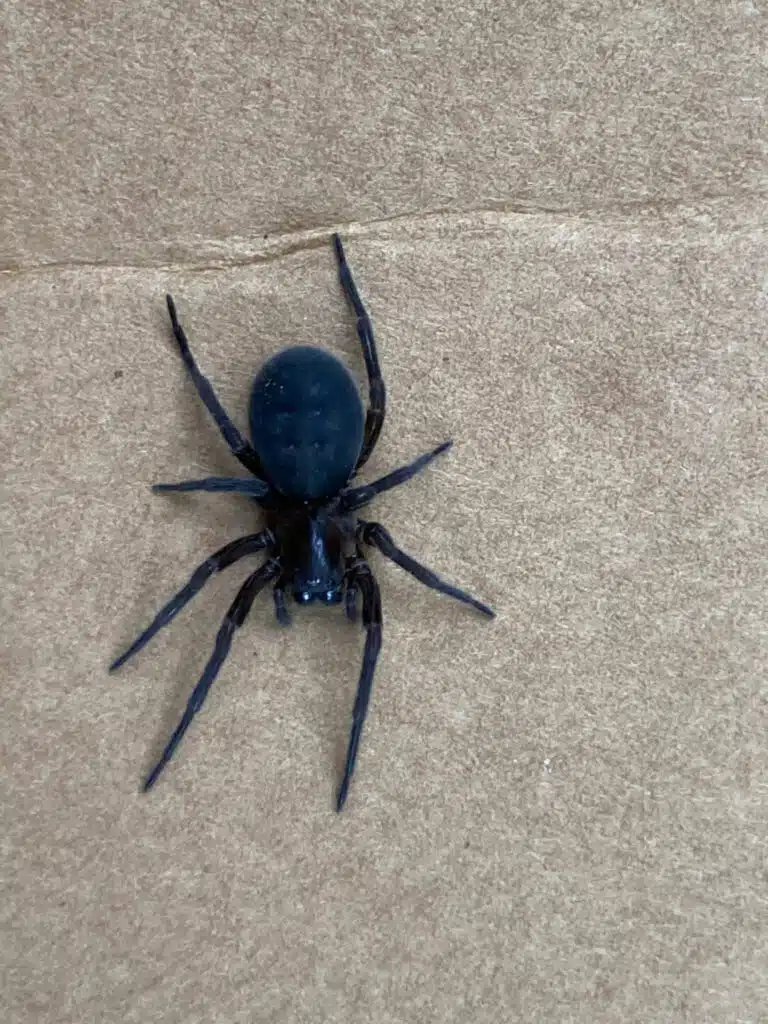
Scientific name: Amaurobius ferox.
Common name: black lace-weaver.
The black lace weaver is a nocturnal spider with females growing to 16mm and males to 10mm in body length. They are dark, predominantly shades of tan, red, brown, and blue/black.
Their rounded dark abdomen has a pale skull pattern, making these spiders easy to identify. They are common near man-made structures, hiding in cellars and under logs. They can make their way indoors.
This spider is native to Europe and can be found in North America, New Zealand, and Eastern Europe.
They are known to bite, which causes mild intense pain, similar to a bee sting. There is usually swelling, redness, and pain present. A bite from this spider is not considered a medical emergency.
12. Singapore Blue
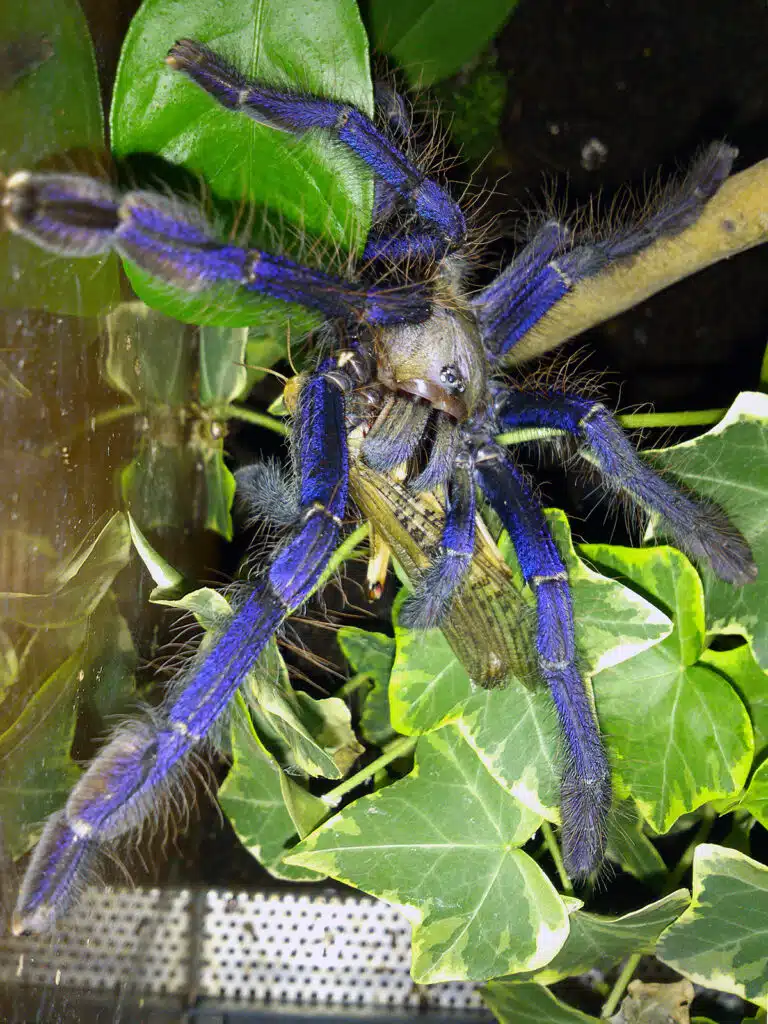
Scientific name: Omothymus violaceopes.
Common name: Singapore blue.
Singapore blues are large, tree-living tarantulas. They come from Singapore and Malaysia. They can grow to 23cm in leg span. Their legs are bright blue with a golden or brown carapace.
Females tend to be more vibrant in color than males. These Old World tree-dwelling tarantulas have a fast growth rate. They are exceptionally fast and will bite if provoked.
They are shy and spend a lot of time in their shelters, located in tall trees. Their bites are painful, due to the size of their fangs.
13. Bold Jumping Spider
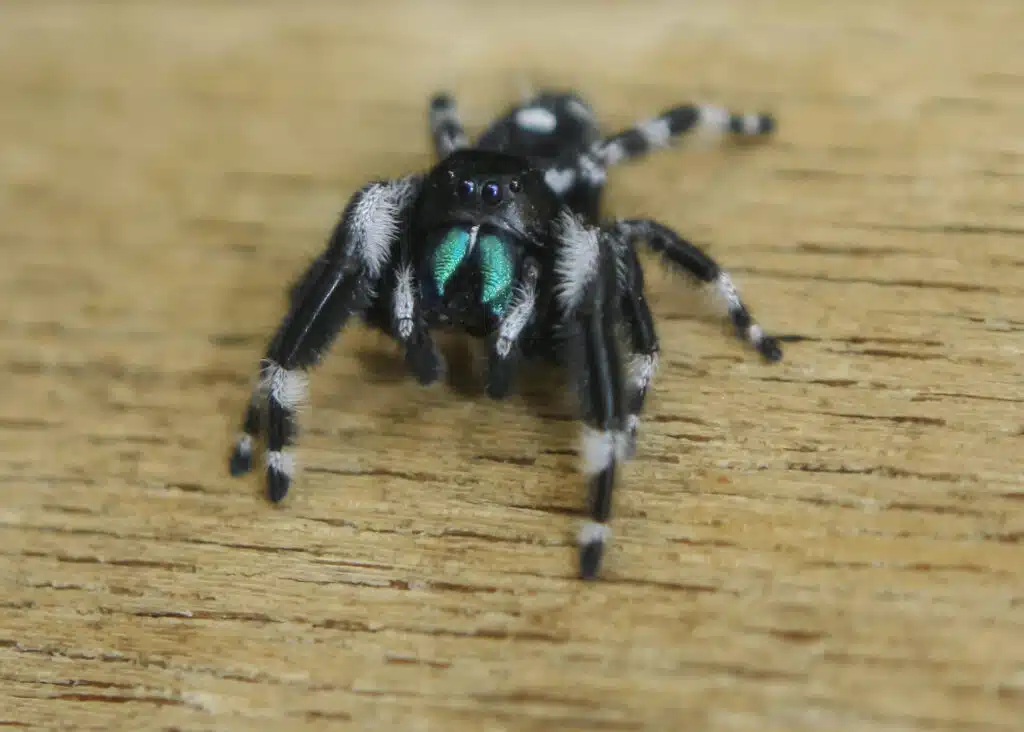
Scientific name: Phidippus audax.
Common name: bold jumping spider, bold jumper.
Bold jumping spiders are common in North America. They can be easily identified with their large size and iridescent chelicerae (mouthparts). These spiders have excellent vision, along with being able to jump more than four times their body length.
The male can grow to 15mm in body length, with the female being larger at around 18mm in body length. These black jumping spiders have spots and stripes on their legs and abdomen The spots are orange when they are juveniles and turn white with each molt.
In Florida, these spiders have orange, red, or yellow spots. They all have bright metallic blue to green mouthparts. Being ambush predators, they prefer open areas where they can hunt for insects.
Their webbing is only used to lay eggs, hide and molt. You can find the bold jumping spider in grasslands and fields, often seen on walls, in gardens, and on fences.
14. Blue-foot Baboon
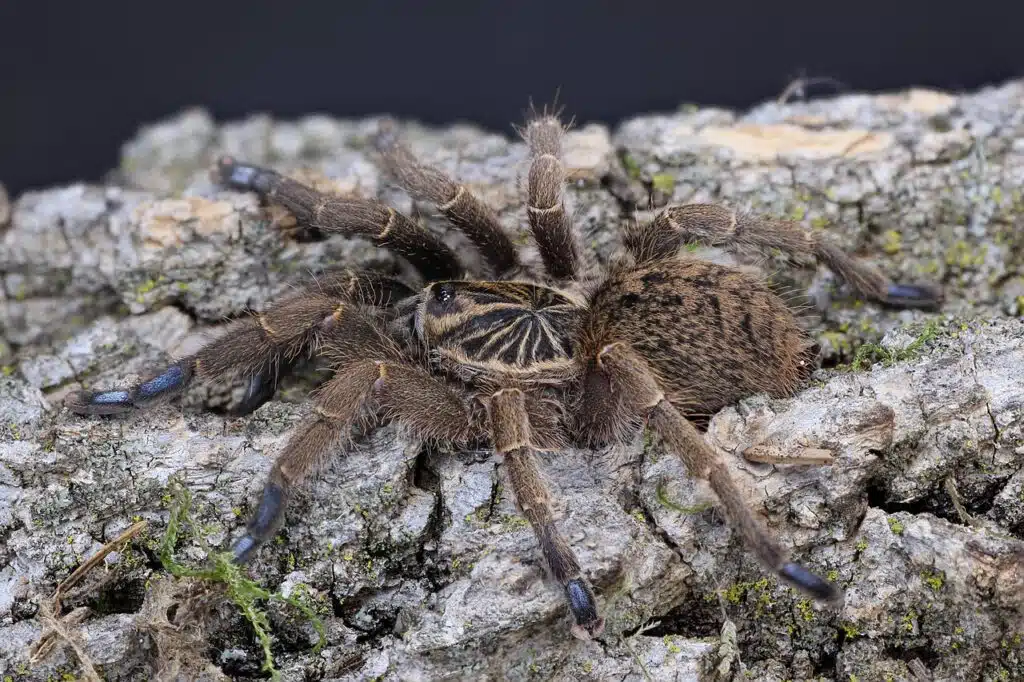
Scientific name: Idiothele mira.
Common name: blue-foot baboon, trap-door tarantula.
The blue foot baboon spider is also known as a trap door tarantula. It is endemic to South Africa and popular in the pet trade. These spiders have blue on the ventral side of their metatarsi and tarsi on each of their legs.
These are small tarantulas, with adult females growing to 4.5 inches in leg span. They rarely leave their burrows and are not commonly encountered. They are distinguished by their bright blue toes.
The carapace is black and gold with a black starburst pattern. The golden abdomen has black specks.
15. Madagascar Hermit Spider
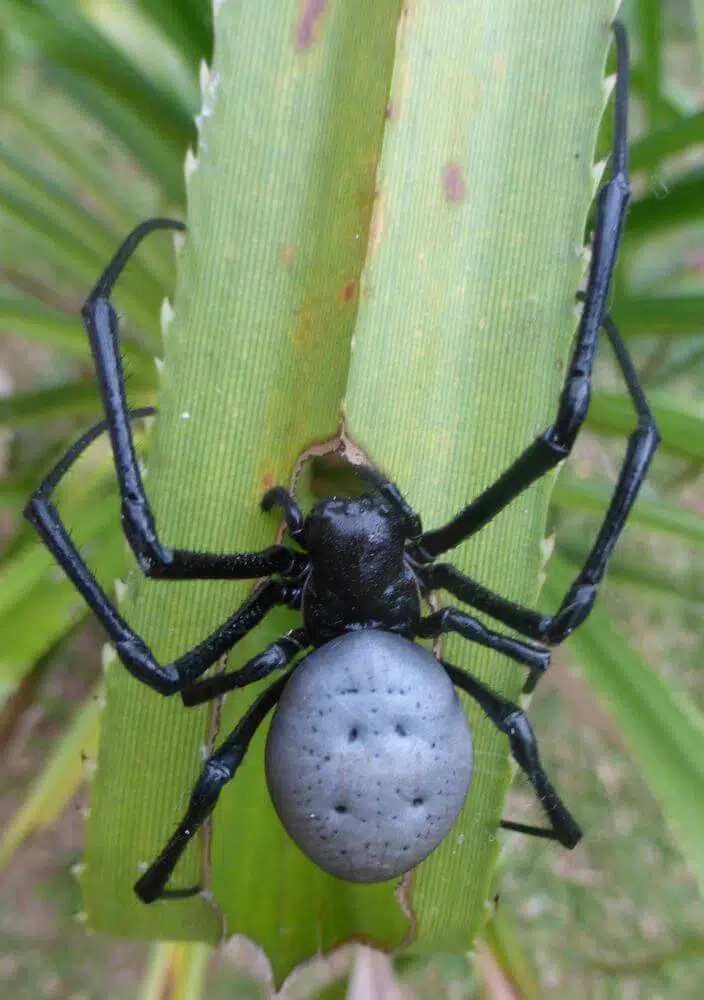
Scientific name: Nephilingis livida.
Common name: Madagascar Hermit Spider.
The Madagascar hermit spider is endemic to Madagascar and the nearby islands. Their abdomens can range from blue or purple to brown or cream. Females can grow to 24mm in body length.
Males grow to 5mm with a yellow to brown colored sternum and grey abdomen. There are white dots on the abdomen. They are frequent visitors to human dwellings in Madagascar but are not dangerous to humans.
16. North Queensland Jumping Spider
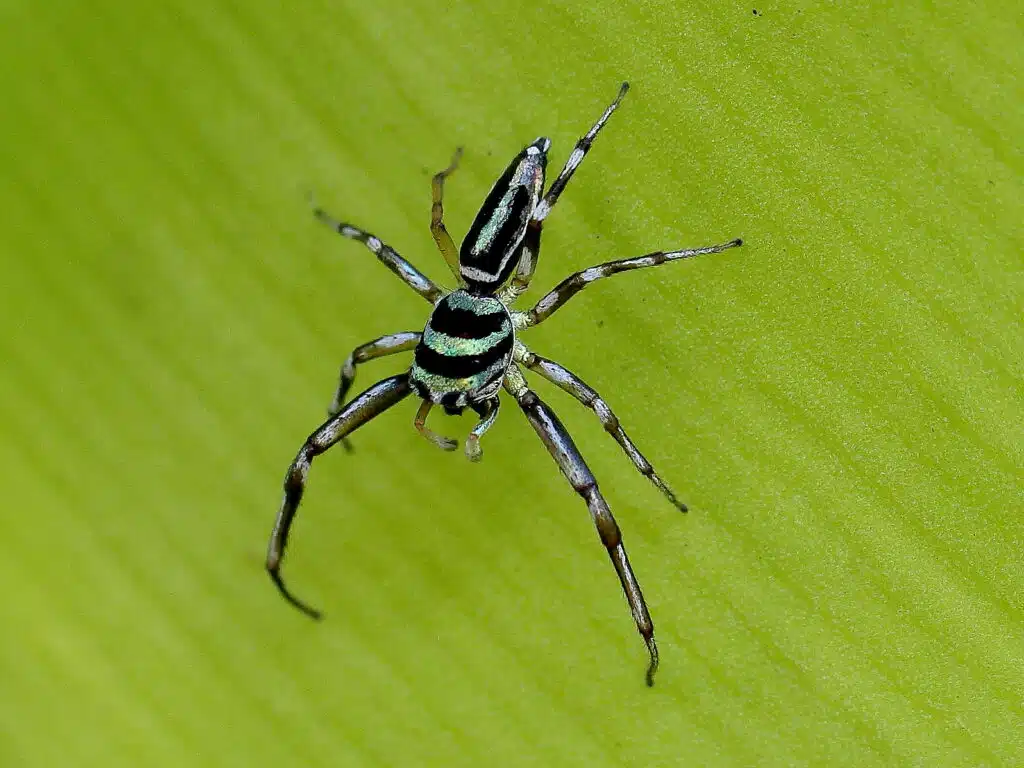
Scientific name: Cosmophasis micarioides.
Common name: North Queensland Jumping Spider, Sparkling Northern Jumping Spider.
While blue spiders might be rare, all male Northern Queensland Jumping Spiders are partly blue.
They feature different coloring compared to females as they show blue stripes across the thorax and a vertical blue stripe across the abdomen.
Some color variants include green-blue coloring for these stripes.
Growing to a size of just over 0.2 inches, male Northern Queensland Spiders are also considerably different from females.
The female of the species has a brown ground color with white, black, and green stripes across the thorax and the abdomen.
The legs of the female are also slightly translucent while the legs of the male are darker.
Spiders of this genus are also often categorized among narrow-abdomen species. This is a spider with a thin elongated abdomen.
Male Northern Queensland Jumping Spiders have slightly narrower abdomens compared to females.
Both males and females are small, compared to other spiders. They grow to a size of up to 0.2 and 0.26 inches.
17. Socotra Island Blue Baboon Spider
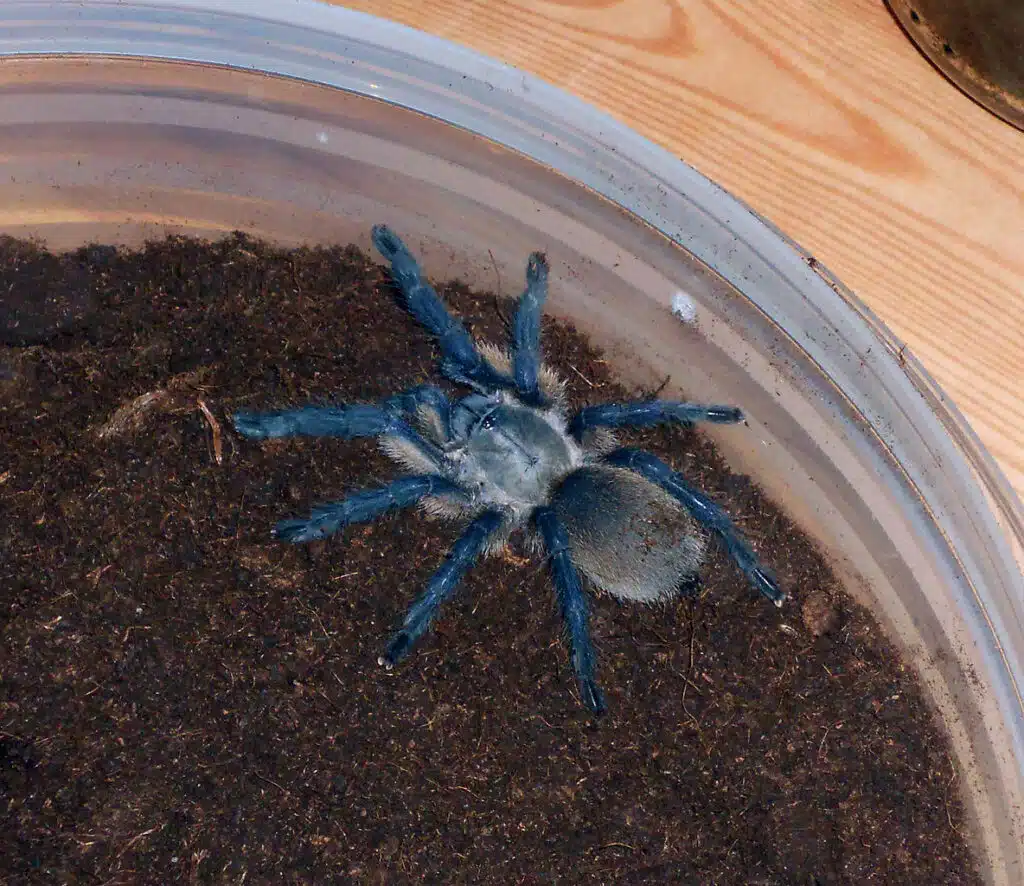
Scientific name: Monocentropus balfouri.
Common name: Socotra Island Blue Baboon Tarantula, Blue Baboon Tarantula.
Named after its native Socotra Island in the Indian Ocean, The Socotra Island Blue Baboon Spider is a species dominated by blue nuances.
Various blue nuances are seen across its body as follows.
Blue-gray colors are specific to the carapace of the tarantula. This is an area of its body that also displays white lateral hairs.
Mostly gray nuances are characteristic of its abdomen while its legs are bright blue.
Other morphs of the species also show different leg colors. There’s a common purple morph with purple legs and a gray thorax.
Like most tarantulas, The Socotra Island Blue Baboon Spider is seen in captivity around the world.
Males might be cheaper to purchase as they also live less than females who easily survive more than a decade.
The tarantula is known to need good substrate as a burrowing spider.
Size-wise, these spiders are also very small. They grow to a maximum size of 0.21 inches with some of the smaller spiders of the species measuring only 0.19 inches.
18. Common Leaf-beetle Jumping Spider
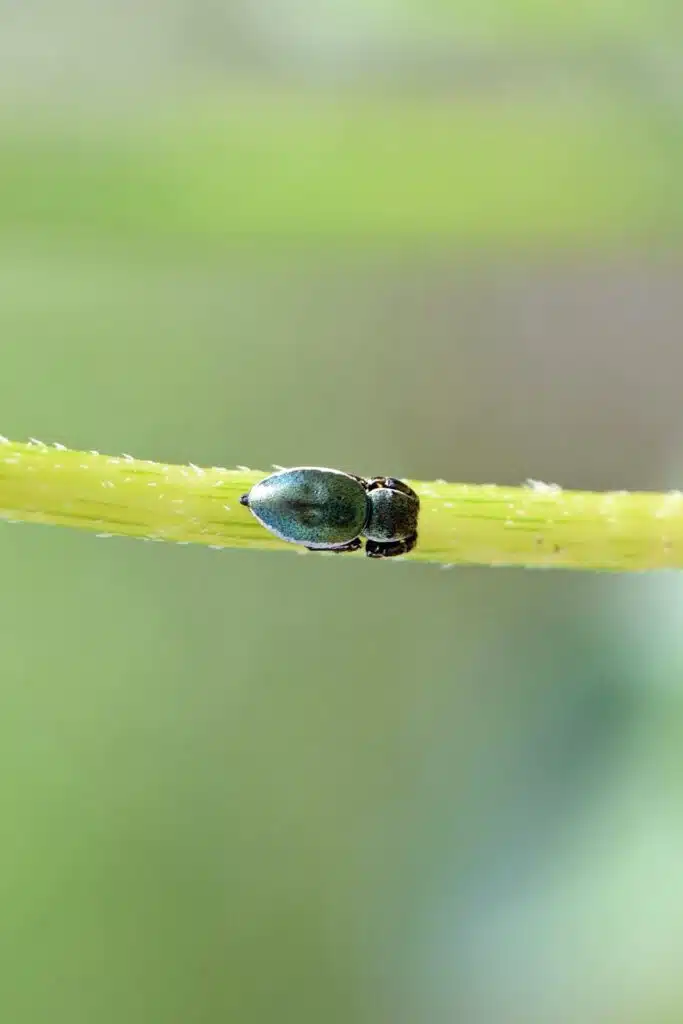
Scientific name: Sassacus papenhoei.
Common name: Common Leaf-beetle Jumping Spider.
As a type of jumping spider, The Common Leaf-beetle Jumping Spider moves by catapulting itself a few times its body size.
This is a species that comes in different colors and which is also known for having a different appearance for males and females.
Males can be black, blue, and even green with white or silver margins. Females are mostly blue-green.
The blue nuances on males also vary from pure navy to bright blue. The male can also be mostly black with just a few bright areas in the form of carapace and abdomen margins.
Males of the species can also have a black carapace with colored tiny spots as well as green-blue abdomens.
19. Elegant Golden Jumping Spider
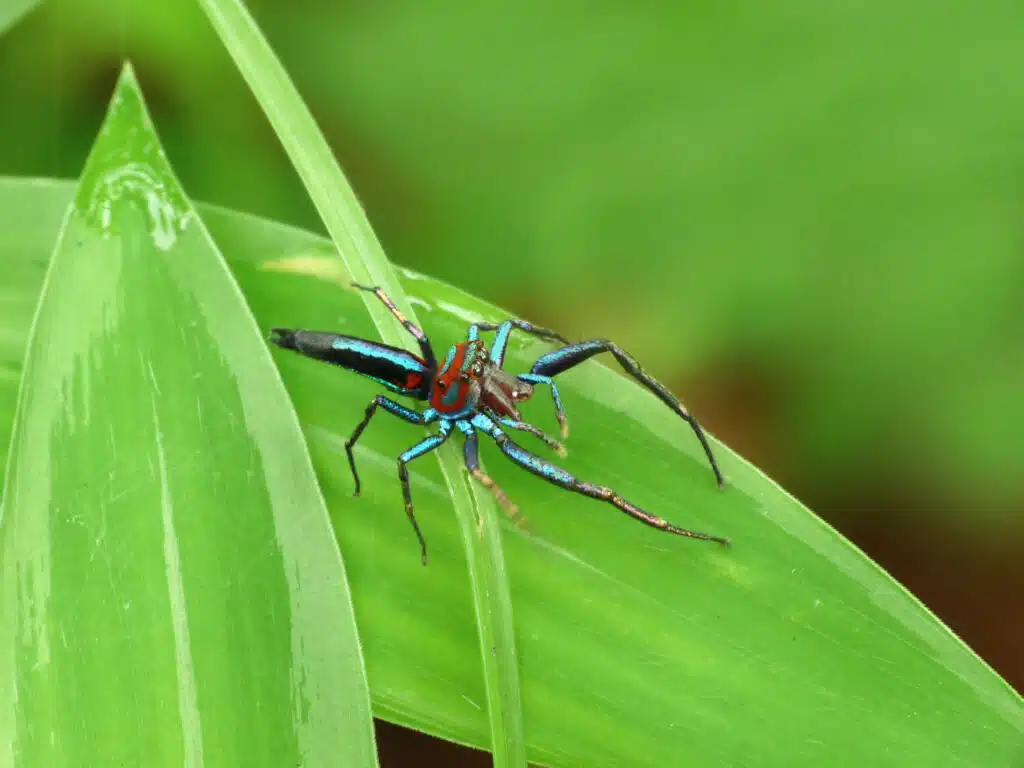
Scientific name: Chrysilla lauta.
Common name: Elegant Golden Jumping Spider.
Mostly blue nuances dominate the appearance of The Elegant Golden Jumping Spider.
This species has metallic blue nuances on its legs and abdomen. It also features metallic blue stripes across its mostly dark orange carapace.
Its blue nuances also vary with the darkest blue sections being seen on its legs and striped abdomen while its lightest blue stripes are seen on its orange carapace.
Elegant Golden Jumping Spiders live across woodlands and grasslands.
They have a widespread East Asia habitat from China to Vietnam. Much of its life is unknown as the species is not often found around homes and in urban areas.
Morphs of the species have also been males which come with additional colors such as orange and magenta, but still show a few blue stripes.
20. Splendid Peacock Spider
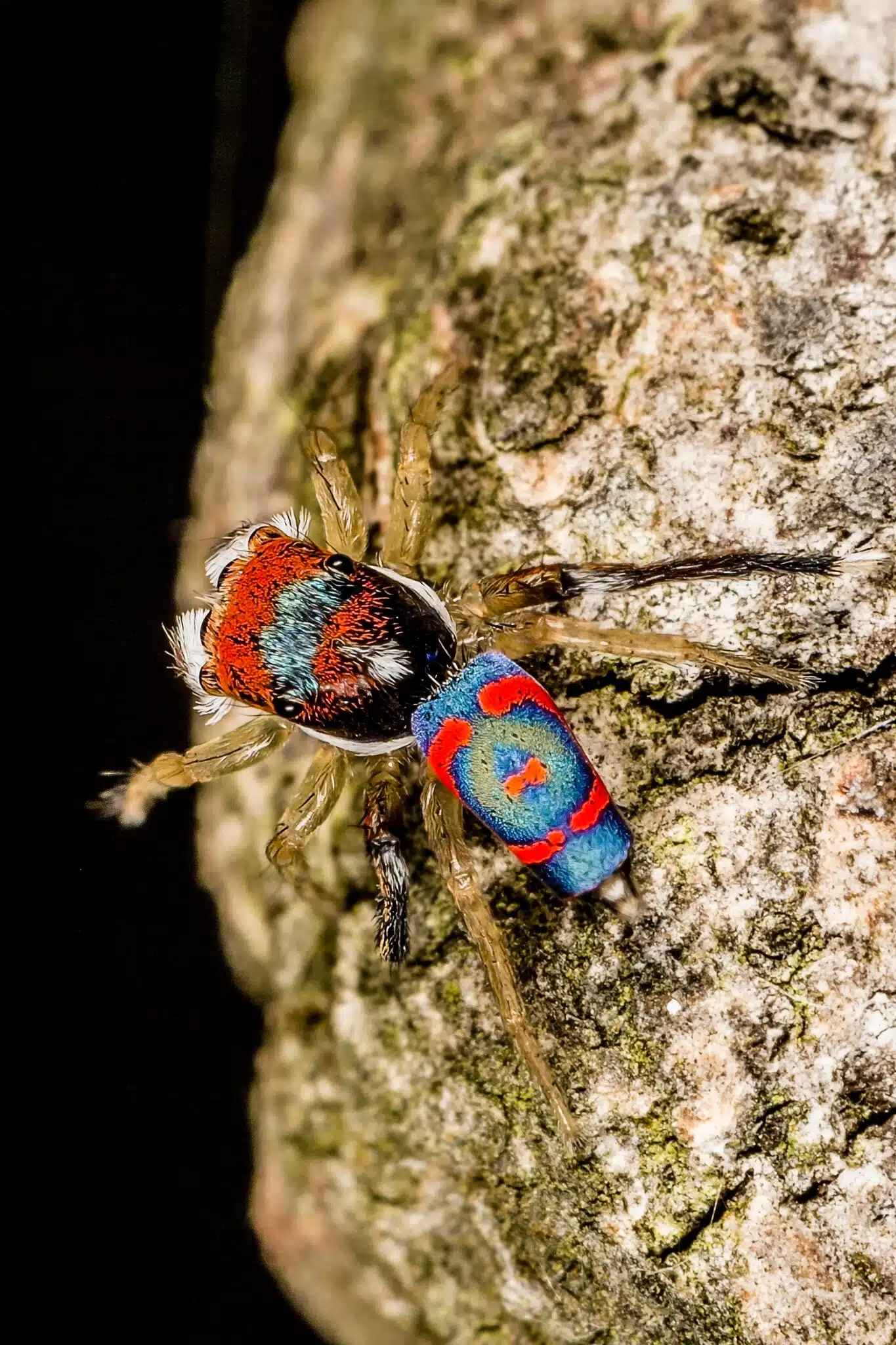
Scientific name: Maratus splendens.
Common name: Splendid Peacock Spider.
The bright coloring with rare abdominal patterns inspires the name of this peacock-like spider.
Peacocks are known for their long blue necks and contrasting colored patterns.
A blue abdomen is also specific to The Splendid Peacock Spider.
This is a species with a bright blue nuance across its abdomen and contrasting interrupted red circles and dots that decorate this colorful area.
The cephalothorax of the spider is mostly red while also featuring stripes. Unlike the red stripes on the abdomen, the stripes here are mostly black.
Additional white hairs are seen on top of its head while the legs of the spider show a combination of brown, black, and white sections.
Females of the species are less colorful and dominated by brown, black, and white mottling.
21. Red-and-blue Opadometa
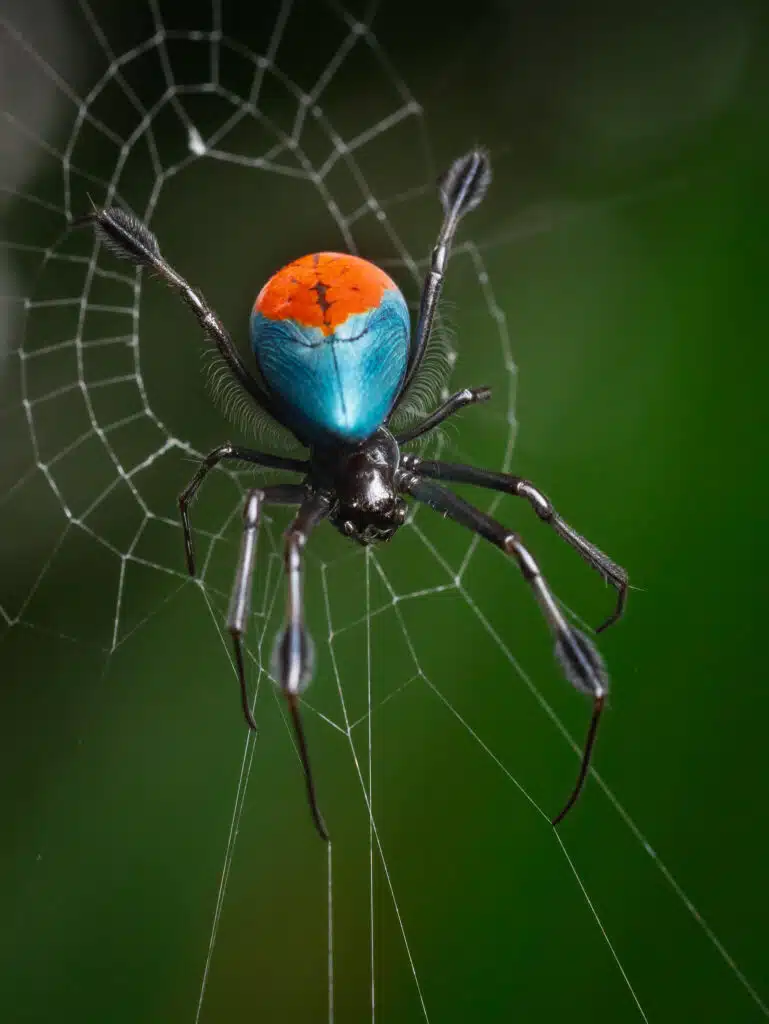
Scientific name: Leucauge sarawakensis.
Common name: Red-and-blue Opadometa.
Not all spiders of the world are well-documented or even documented at all. Red-and-blue Opadometa spiders are among the species which have just been documented.
This rare type of spider has a unique teardrop shape which makes it look almost unlike any other spider.
Its unibody in the shape of a pear or a teardrop comes with orange-red wider sections and iridescent blue narrower sections, closer to the head.
These sections are only united by a blue mid-dorsal line which also separates into additional diagonal stripes on its red section, similar to the veins of leaves.
Black sections are also represented by the shiny black legs of the spider.
A mostly blue variant is also noted for this spider. This variant has a yellow wider abdomen section instead of a standard orange-red section.
Mostly found in forests, this is a type of web-weaving orbweaver spider with an unconfirmed lifespan.
22. Black-spotted Peacock Spider
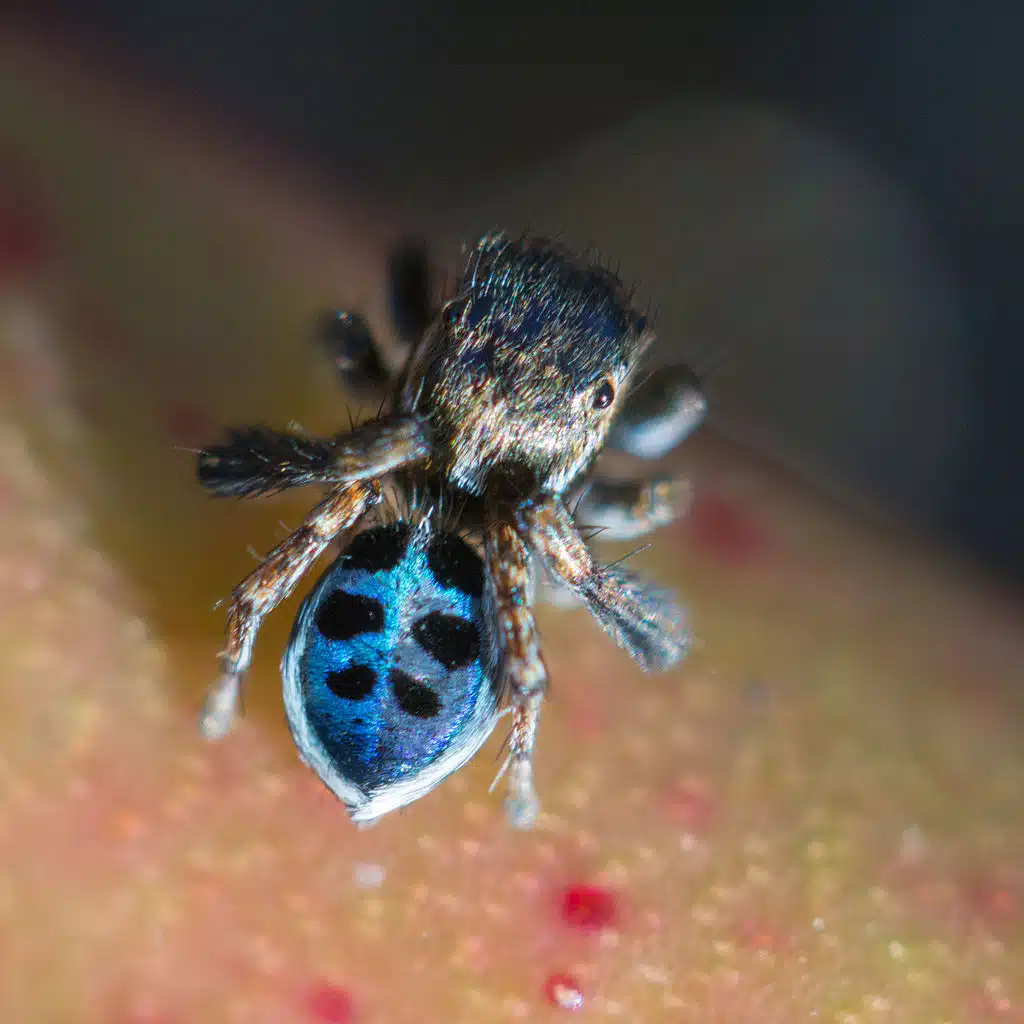
Scientific name: Maratus nigromaculatus.
Common name: Black-spotted Peacock Spider.
A mostly blue appearance is specific to The Black-spotted Peacock Spider.
This is a species endemic to Australia with a highly colorful appearance but named after the black patterns on its abdomen.
Mostly bright blue, the abdomen of The Black-spotted Peacock Spider is also slightly metallic.
6 black spots arranged in rows of 3 decorate its bright blue abdomen. These spots are larger towards the carapace.
The carapace itself shows a combination of long hairs of a gray and blue color. A small number of the hairs in this area are also bright brown with a bronze hue.
The legs of Black-spotted Peacock Spiders are also mostly blue, gray, and brown and stand out with their hairy profile.
As with all types of peacock spiders, The Black-spotted Peacock Spider uses its colorful abdomen as a tool for communication.
It raises it and flickers it, almost showing dancing movements with the most colorful parts of its body.
From some angles, the bright blue metallic abdomen of the species may even look like it’s glowing.
23. Unusual Peacock Spider
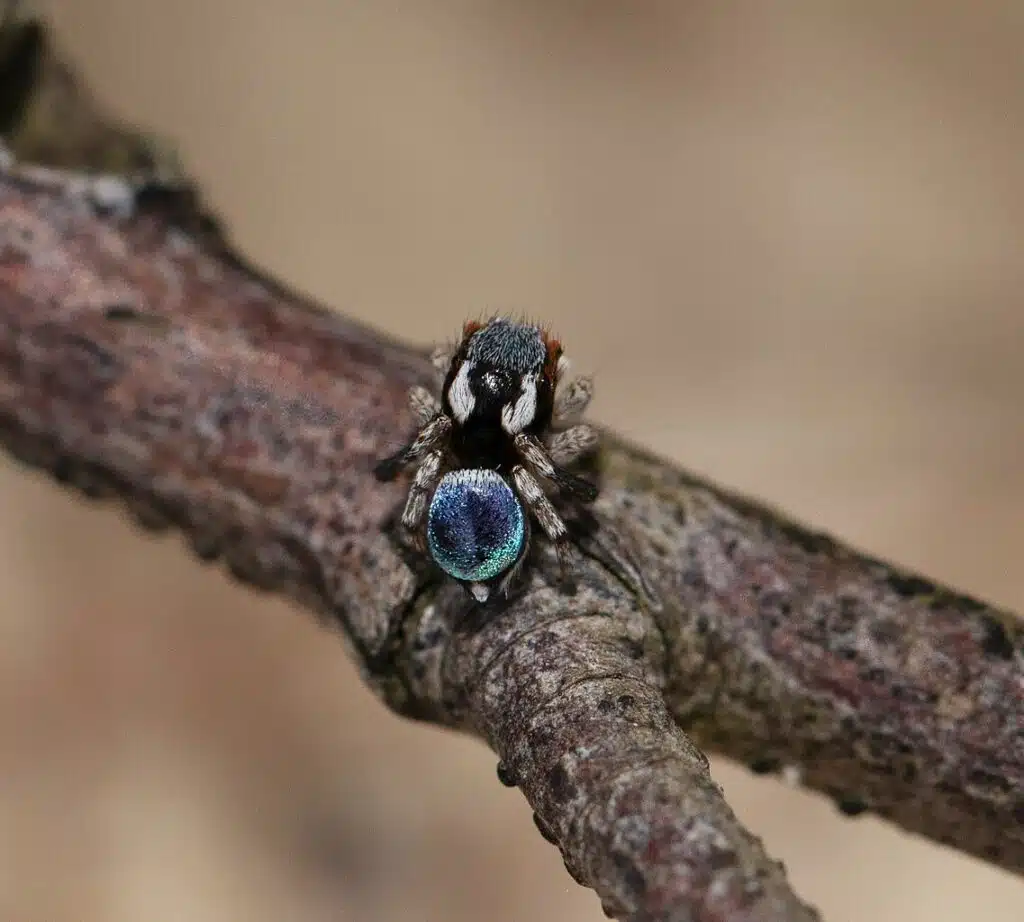
Scientific name: Maratus anomalus.
Common name: Unusual Peacock Spider.
A mostly blue appearance with plenty of colorful hues is specific to The Unusual Peacock Spiders.
Most of these spiders of the peacock family are highly colorful, and bright, and even appear to come in different colors.
The way light is reflected by their metallic blue bodies almost makes it look like the spider has a different color.
Its abdomen is blue, brown-purple, and black. Its neon-blue section has an iridescence to it that may change in direct sunlight.
The carapace is mostly blue, with black, white, yellow, and bronze-brown additional sections, especially around the sides.
Its legs are mostly off-white and black, but they do show additional scarce blue hairs.
Bright blue, navy blue, metallic blue, turquoise blue, and purple-blue are some of the most common blue nuances this type of spider comes in.
Its habitat is limited to Australia but its colorful appearance makes it a top pet spider around the world.
24. Coastal Peacock Spider
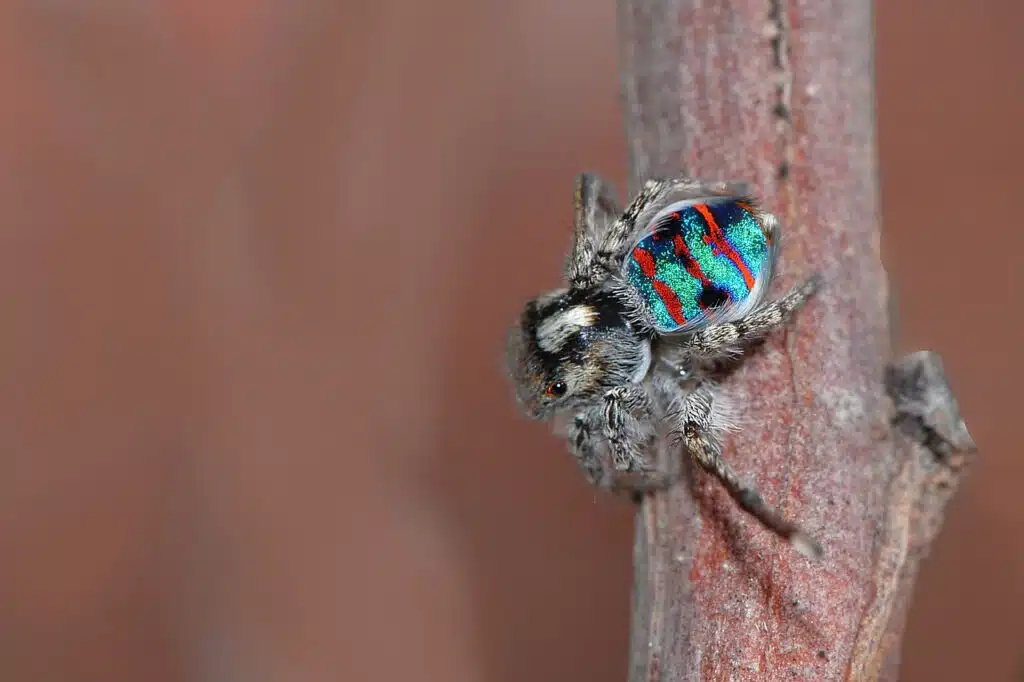
Scientific name: Maratus speciosus.
Common name: Coastal Peacock Spider.
While some of the smallest types of blue spiders in the world, Coastal Peacock Spiders are still highly visible given their bright appearance.
This is a species that lives in some of Australia’s coastline, particularly in New South Wales.
Males of the species are more colorful, supposedly to attract females.
They use movements, colors, and even vibrations to attract a potential mate.
A male Coastal Peacock Spider has a bright blue abdomen with red and black stripes and additional white marginal hairs.
This abdomen can be flicked up and even bent forward until it touches the thorax, a movement used during courtship displays.
A mostly black appearance is more specific to its thorax.
The spider even uses its ability to flick its abdomen up to vibrate the sandy soils it inhabits.
Together with the colors, its vibrations help males get the attention of the female spider.
25. North American Cobalt Tarantula

Scientific name: Aphonopelma mooreae.
Common name: North American Cobalt Tarantula, Mexican Jade Fuego Tarantula.
A colorful species, The North American Cobalt Tarantula is named after its cobalt-blue thorax color.
This is a type of iridescent color that has a bright nuance that shines in the sun.
North American Cobalt Tarantulas also exhibit dark blue legs. The blue nuance on the legs is darker and mixed with black hairs and brown hairs on its hind pairs of legs.
The abdomen of The North American Cobalt Tarantula is mostly orange-brown with a central black stripe.
Variants of this species include a green color tarantula. This green variant shows both green thoraxes and green legs while the abdomen is pale brown.
Depending on the gender, these types of tarantulas can also be mostly black, with bright brown abdomens without any green or blue hairs.
Are Blue Spiders Poisonous?
The majority of blue spiders are not poisonous. It’s important to remember that all spiders are venomous and a bite will cause some pain, swelling, and redness.
The blue tarantulas have urticating hairs, which causes irritation when it makes contact with the human skin. They flick the hairs on their abdomen when they are provoked.
The red-headed mouse spider is the most venomous to humans. A bite can cause muscle cramping and pain.
Summary
Whether you are a spider enthusiast looking to add a new addition to your collection or you are cuprous about a spider you encountered, the blue spiders of the world are beautiful and interesting.
With only 25 spiders being blue or having blue on their bodies, seeing one of these in the wild is a great photo opportunity. Remember to keep your distance and don’t provoke the spider, even a bee sting equivalent bite can be uncomfortable and painful.
Further Reading: